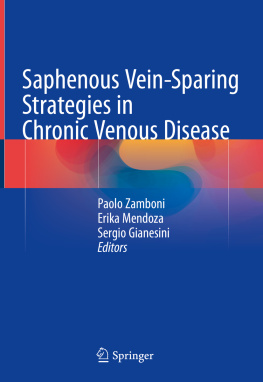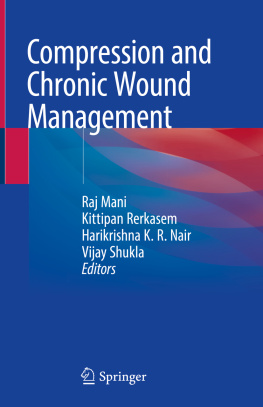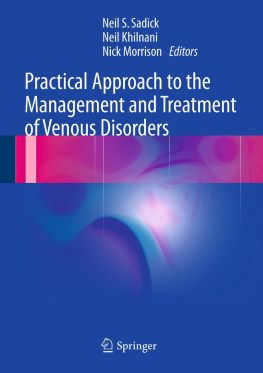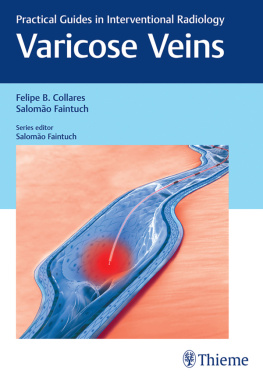Editors
Paolo Zamboni
School of Vascular Surgery and Vascular Diseases Center, University of Ferrara, Ferrara, Italy
Unit of Translational Surgery, AOU Ferrara, Ferrara, Italy
Erika Mendoza
Venenpraxis Wunstorf, Wunstorf, Niedersachsen, Germany
Sergio Gianesini
Translational Surgery Unit-Vascular Disease Center, University of Ferrara Vascular Disease Center, Ferrara, Italy
ISBN 978-3-319-70637-5 e-ISBN 978-3-319-70638-2
https://doi.org/10.1007/978-3-319-70638-2
Library of Congress Control Number: 2018935125
Corrected publication 2018
Springer International Publishing AG, part of Springer Nature 2018
This work is subject to copyright. All rights are reserved by the Publisher, whether the whole or part of the material is concerned, specifically the rights of translation, reprinting, reuse of illustrations, recitation, broadcasting, reproduction on microfilms or in any other physical way, and transmission or information storage and retrieval, electronic adaptation, computer software, or by similar or dissimilar methodology now known or hereafter developed.
The use of general descriptive names, registered names, trademarks, service marks, etc. in this publication does not imply, even in the absence of a specific statement, that such names are exempt from the relevant protective laws and regulations and therefore free for general use.
The publisher, the authors and the editors are safe to assume that the advice and information in this book are believed to be true and accurate at the date of publication. Neither the publisher nor the authors or the editors give a warranty, express or implied, with respect to the material contained herein or for any errors or omissions that may have been made. The publisher remains neutral with regard to jurisdictional claims in published maps and institutional affiliations.
This Springer imprint is published by the registered company Springer International Publishing AG part of Springer Nature
The registered company address is: Gewerbestrasse 11, 6330 Cham, Switzerland
Foreword
During the 1970s and in the 1980s, we had more and more patients who needed a saphena bypass wherein the saphenous vein was unfortunately destroyed by a previous surgical or endovenous treatment. I was struck by our schizophrenic behaviour which consisted of, on the one hand, the saphenous vein destruction for the benign varicose disease and, on the other hand, lamenting for its absence when we needed it to perform a venous bypass for a critical or life-threatening arterial or coronary obstruction. So, as a former psychiatrist, I decided to confront and treat my insanity.
In addition to conservative treatments as foot elevation, bandaging and use of compression stockings, I tried to find a surgical treatment which could also preserve the saphenous capital. My observations of the varicose veins disappearance when I lifted the feet of my patients combined with the Trendelenburg and Perthes manoeuvres effects convinced me that the cause of the venous insufficiency and its symptoms was just a haemodynamic impairment of the venous flows and pressure control.
Then, from this basis and thanks to the studies of the venous pressure principally published by Bjordal and the revolutionary capability of recent echo-Doppler ultrasound devices, I could better figure out the better haemodynamic venous system and its anomalies. It resulted in proposals of venous pathophysiological haemodynamic principles as dynamic fractioning of hydrostatic pressure, various venous shunt patterns, re-entry concept, transmural pressure control as the target of any rational treatment, location of not yet individualized pelvic leak points, haemodynamic venous cartography, and finally the necessary conservation of the venous network for a correct drainage of the tissues and prevention of recurrence. These concepts were the basis of the CHIVA cure (French acronym for cure Hmodynamique et Conservatrice de lInsuffisance Veineuse en Ambulatoire) published in 1988.
As conservation is a pillar, CHIVA was received as provocative nonsense because, so far, the destructive paradigm was dominant. Indeed, for around a century, research, studies and devices where focused on killing the veins because the treatment failures and recurrences where attributed to the veins left behind. Indeed, CHIVA is based on dramatically different pathophysiological rational. Its concepts were verified by further experimental evidence. Thanks to hundreds of studies, some RCTs and a Cochrane review, achieved by various authors over Europe, CHIVA is today validated more successful than destructive methods and reaches, at the same time, both targets of treating efficiently the venous insufficiency and preserving the venous capital for future bypass.
CHIVA is also a scientific and intellectual challenge which demands a reconsideration of the mainstream knowledge and personal habits, a steep learning curve of the appropriate venous haemodynamics and its related duplex scan assessment. We cannot play a game of chess with the rules for checkers even if the board is identical. The same is for CHIVA. The rules of destructive methods cannot fit to the conservative CHIVA.
Conservative or ablative methods, as well as invasive and non-invasive or laser and other advanced devices, are powerful marketing arguments but not always medically fair. The conservative procedures are relevant only when they are better than the ablative in terms of risks/benefits ratio. Non-invasive procedures are not necessarily safe. CHIVA is feasible in outpatients with mini-invasive surgery.
Patient information should point out the risks/benefits based on medical evidence. That is like kicking down an open door if we refer to the Hippocratic oath I am following that system of regimen which, according to my ability and judgement, I consider for the benefit of my patients, and abstain from whatever is deleterious and mischievous. Furthermore, the patient informed consent obliges to inform the patient about the nature and purpose and risks and benefits of the proposed treatment as well as the alternatives.
Unfortunately, reality is not so. Ignorance, cynicism, competition, greed and conflicts of interest are still to be taken into account.
I would like this book to revive the fair Hippocratic oath by permitting the phlebologist to better inform and treat the patient. Remind him that varicose veins are usually benign and may be treated or not according to his cosmetic or comfort expectation. In case of skin changes and ulcers, easy efficient procedures on transmural pressure decrease are available. In addition, the CHIVA concepts and strategy are applicable to deep venous diseases, particularly post-thrombotic, and also to venous malformations.
Many thanks and congratulations to the authors who are renowned world experts as researchers and practitioners in phlebology. They report and explain extensively and clearly the venous haemodynamic pathophysiology with the relevant contribution of other eminent colleagues, who improved the CHIVA strategy and tactics.
Claude Franceschi












